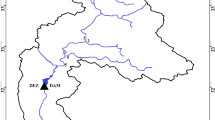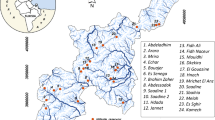Abstract
Since sediment concentration is an effective factor on increasing debris flood’s peak flow and damages from floods, developing new models to predict the sediment concentration of debris floods has crucial importance. In this study, a hybrid SVR-PSO model was proposed to predict the concentration of sediment in typical and debris floods, and it was examined in three basins located in Gilan, Mazandaran, and Tehran Provinces, Iran. Mean elevation and slope of the basin, the area of the basin, current day’s rainfall, the rainfall of previous days (1–3 days before flood) for all rain-gauge stations of the basins, as well as the discharge of the previous day, were used as the input variables of the model. Then, various combinations of variables were tested to assess the factors influencing the concentration of sediment in typical and debris floods in order to find the best variable combination with a high performance in predicting the concentration of sediment in the studied floods. The results showed that basin elevation, current day’s rainfall, previous day’s discharge, rainfall of the previous day, basin area, rainfall of the previous two days, basin slope, and rainfall of the previous three days were the key factors influencing the concentration of sediment in typical and debris floods, respectively. Coefficient of determination, root mean square error, and mean absolute percentage error were estimated 0.96, 0.003, and 14.38% for the proposed model at the testing phase, respectively. This implies model’s good performance for predicting the concentration of sediment in typical and debris floods so that the present model can provide reliable predictions of flood character in basins.



Similar content being viewed by others
References
Adamowski J (2013) Using support vector regression to predict direct runoff, base flow and total flow in a mountainous watershed with limited data in Uttaranchal, India. Annals of Warsaw University of Life Sciences-SGGW. Land Reclamation 45(1):71–83
Banihabib ME, Bahram E (2009) Experimental analyses of sedimentation in the slit dam Reservoir. World Environmental and Water Resources Congress, ASCE, Great Rivers 5845–5856
Banihabib ME, Forghani A (2017) An assessment framework for the mitigation effects of check dams on debris flow. Catena 152:277–284
Banihabib ME et al (2020) Bayesian networks model for identification of the effective variables in the forecasting of debris flows occurrence. Environ Earth Sci 79:1–15
Byun H, Lee S-W (2002) Applications of support vector machines for pattern recognition: a survey. International Workshop on Support Vector Machines, Springer 2388:213–236
Cannon S et al (2007) Storm rainfall conditions for floods and debris flows from recently burned basins in southwestern Colorado and Southern California. AGUFM 2007:H43F–H1692F
Chen K-Y, Wang C-H (2007) Support vector regression with genetic algorithms in forecasting tourism demand. Tour Manag 28(1):215–226
Chen S-T, Yu PS, Tang YH (2010) Statistical downscaling of daily precipitation using support vector machines and multivariate analysis. J Hydrol 385(1–4):13–22
Crosta GB, Frattini P (2008) Rainfall-induced landslides and debris flows. Hydrol Processes: An Int J 22(4):473–477
Dobbin KK, Simon RM (2011) Optimally splitting cases for training and testing high dimensional classifiers. BMC Med Genet 4(1):31
Fattahi H, Karimpouli S (2016) Prediction of porosity and water saturation using pre-stack seismic attributes: a comparison of Bayesian inversion and computational intelligence methods. Comput Geosci 20(5):1075–1094
Fattahi H, Gholami A, Amiribakhtiar MS, Moradi S (2015) Estimation of asphaltene precipitation from titration data: a hybrid support vector regression with harmony search. Neural Comput Applic 26(4):789–798
Gholami R, Moradzadeh A, Maleki S, Amiri S, Hanachi J (2014) Applications of artificial intelligence methods in prediction of permeability in hydrocarbon reservoirs. J Pet Sci Eng 122:643–656
Hamel LH (2009) Knowledge discovery with support vector machines. John Wiley & Sons, Inc., Hoboken, NJ
Hassan-Esfahani L, Banihabib ME (2016) The impact of slit and detention dams on debris flow control using GSTARS 3.0. Environ Earth Sci 75(4):328
Hirano M (1997) Prediction of debris flow for warning and evacuation, In: Lecture notes in earth sciences, recent developments on debris flows, edited by: Armanini, A. and Michiue, M. Springer, Berlin Heidelberg, New York 64:7–26
Hirano M, et al. (1997) Estimation of hazard area due to debris flow. In: Debris-Flow Hazards Mitigation: Mechanics, Prediction, and Assessment; edited by Chen, C-L., Proc. 1st international conference, San Francisco, California. American Society of Civil Engineers 697–706
Hu W, Yan L, Liu K, Wang H (2016) A short-term traffic flow forecasting method based on the hybrid PSO-SVR. Neural Process Lett 43(1):155–172
Huang C-L, Dun J-F (2008) A distributed PSO–SVM hybrid system with feature selection and parameter optimization. Appl Soft Comput 8(4):1381–1391
Huang C-L, Wang C-J (2006) A GA-based feature selection and parameters optimizationfor support vector machines. Expert Syst Appl 31(2):231–240
Jan C-D, Chen C-L (2005) Debris flows caused by typhoon herb in Taiwan. In: Jakob, M., Hungr, O. (Eds), Debris-Flow Hazards and Related Phenomena. Springer, Berlin, Heidelberg 539–563
Jayalakshmi T, Santhakumaran A (2011) Statistical normalization and back propagation for classification. Int J Comput Theory Eng 3(1):1793–8201
Kalanaki M, Soltani J (2013) Simulation and performance assessment between hybrid algorithms SVR-CACO and SVR-CGA to more accurate predicting of the pipe failure rates. J Novel Appl Sci 2(S3):1054–1063
Kalanaki M et al (2013) The use of hybrid SVR-PSO model to predict pipes failure rates. Int J Sci Eng Res 4(11):1022–1025
Kennedy J, Eberhart R (1995) Particle swarm optimization. Proceedings of the IEEE international conference on neural networks. IEEE Service Center, Piscataway, NJ 4:1942–1948
Kern AN, Addison P, Oommen T, Salazar SE, Coffman RA (2017) Machine learning based predictive modeling of debris flow probability following wildfire in the intermountain Western United States. Math Geosci 49(6):717–735
Lin J-W, Chen CW, Peng CY (2012) Potential hazard analysis and risk assessment of debris flow by fuzzy modeling. Nat Hazards 64(1):273–282
Nikolopoulos EI, Destro E, Bhuiyan MAE, Borga M, Anagnostou EN (2018) Evaluation of predictive models for post-fire debris flow occurrence in the western United States. Nat Hazards Earth Syst Sci 18(9):2331–2343
Poli R, Kennedy J, Blackwell T (2007) Particle swarm optimization. Swarm Intell 1(1):33–57
Ranaee V, Ebrahimzadeh A, Ghaderi R (2010) Application of the PSO–SVM model for recognition of control chart patterns. ISA Trans 49(4):577–586
Riazi A, Türker U (2018) A genetic algorithm-based search space splitting pattern and its application in hydraulic and coastal engineering problems. Neural Comput & Applic 30(12):3603–3612
Sarafrazi S, Nezamabadi-pour H (2013) Facing the classification of binary problems with a GSA-SVM hybrid system. Math Comput Model 57(1–2):270–278
Senoo K et al (1985) Rainfall indexes for debris flow warning evacuating program. Shin-Sabo 38(2):16–21
Shi Y, Eberhart R (1998) A modified particle swarm optimizer. In Proceeding of IEEE International Conference on Evolutionary Computation. IEEE world congress on computational intelligence, pp 69–73
Smola AJ, Schölkopf B (2004) A tutorial on support vector regression. Stat Comput 14(3):199–222
Soebroto AA, Cholissodin I, Frestantiya MT, Arief ZE (2018) Integration method of local-global SVR and parallel time variant PSO in water level forecasting for flood early warning system. Telkomnika 16(3):1193–1200
Takahashi T, Das DK (2014) Debris flow: mechanics, prediction and countermeasures,2nd edition. CRC Press/Balkema, Leiden, the Netherlands
Tan B, Duan A (1995) Study on prediction for rainstorm debris flow along Mountain District rail ways. Natural Disasters 4(2):43–52. (In Chinese)
Tian S, Wang C, Zhang Z (2017) A hybrid method of debris flow velocity estimation based on empirical equation. Int J Heat Technol 35(1):147–152
Vapnik V (1992) Principles of risk minimization for learning theory. In Lippman, D. S., Moody, J. E., and Touretzky, D. S., editors. Advances in Neural Information Processing System (NIPS). Morgan Kaufman, San Mateo, CA 4:831–838
Vapnik VN (1995) The nature of statistical learning Theory. Springer-Verlag, New York
Vapnik V (1998) Statistical learning Theory. Vol. 1. John Wiley & Sons, New York
Vapnik V (2013) The nature of statistical learning theory, Springer science & business media, Berlin
Xiong K, Adhikari BR, Stamatopoulos CA, Zhan Y, Wu S, Dong Z, di B (2020) Comparison of different machine learning methods for debris flow susceptibility mapping: a case study in the Sichuan Province, China. Remote Sens 12(2):295
Yu P-S, Chen ST, Chang IF (2006) Support vector regression for real-time flood stage forecasting. J Hydrol 328(3–4):704–716
Zhang Y, Ge T, Tian W, Liou YA (2019) Debris flow susceptibility mapping using machine-learning techniques in Shigatse area, China. Remote Sens 11(23):2801
Zheng L, Zhou H, Wang C, Cen K (2008) Combining support vector regression and ant colony optimization to reduce NOx emissions in coal-fired utility boilers. Energy Fuel 22(2):1034–1040
Zhuang J, Cui P, Wang G, Chen X, Iqbal J, Guo X (2015) Rainfall thresholds for the occurrence of debris flows in the Jiangjia gully, Yunnan Province, China. Eng Geol 195:335–346
Acknowledgments
The authors would like to express their deep gratitude to Mr. Saeed Mozaffari for his kind contribution to developing the SVR model.
Author information
Authors and Affiliations
Corresponding authors
Additional information
Communicated by: H. Babaie
Publisher’s note
Springer Nature remains neutral with regard to jurisdictional claims in published maps and institutional affiliations.
Rights and permissions
About this article
Cite this article
Kazemi, M.S., Banihabib, M.E. & Soltani, J. A hybrid SVR-PSO model to predict concentration of sediment in typical and debris floods. Earth Sci Inform 14, 365–376 (2021). https://doi.org/10.1007/s12145-021-00570-0
Received:
Accepted:
Published:
Issue Date:
DOI: https://doi.org/10.1007/s12145-021-00570-0




